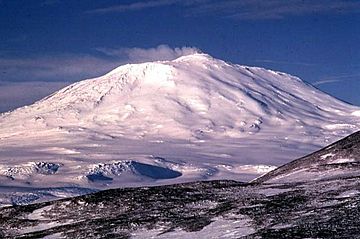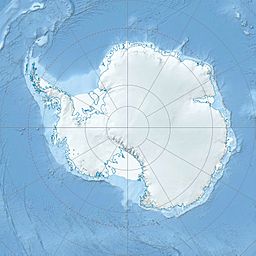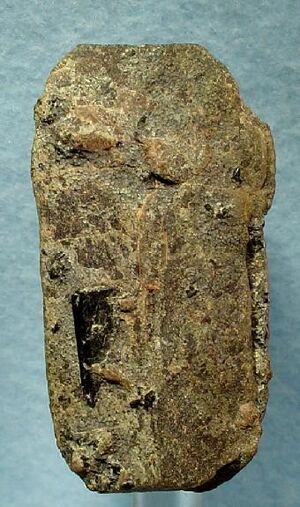Mount Erebus facts for kids
Quick facts for kids Mount Erebus |
|
|---|---|

Mount Erebus
|
|
| Highest point | |
| Elevation | 3,794 m (12,448 ft) |
| Prominence | 3,794 m (12,448 ft) Ranked 34th |
| Listing | Ultra |
| Geography | |
| Location | Ross Island, Antarctica (claimed by New Zealand as part of the Ross Dependency) |
| Topo map | Ross Island |
| Geology | |
| Age of rock | 1.3 million years |
| Mountain type | Stratovolcano (composite cone) |
| Volcanic belt | McMurdo Volcanic Group |
| Last eruption | Currently erupting |
| Climbing | |
| First ascent | 1908 by Edgeworth David and party |
| Easiest route | Basic snow & ice climb |
Mount Erebus is a huge volcano in Antarctica. It is the second-highest volcano on the continent, after Mount Sidley. It is also the highest active volcano in Antarctica and the southernmost active volcano on Earth!
Mount Erebus is located on Ross Island in the Ross Dependency. This island is also home to three volcanoes that are no longer active: Mount Terror, Mount Bird, and Mount Terra Nova.
This volcano has been active for a very long time, about 1.3 million years. It has a special feature called a lava lake inside its main crater. This lake has been there since at least the early 1970s.
Sadly, Mount Erebus was also the site of the Air New Zealand Flight 901 accident in November 1979.
Contents
What Makes Mount Erebus Special?
Mount Erebus is the world's southernmost active volcano. It is part of a "hotspot" where magma from deep inside the Earth comes to the surface.
The top of the volcano has a constant lava lake. This lake is made of a type of lava called phonolite. It's one of only five long-lasting lava lakes on Earth! The volcano often has small eruptions, like Strombolian eruptions. These eruptions come from the lava lake or other small openings inside the main crater.
Scientists find Mount Erebus very interesting. Its eruptions are usually not too strong and happen all the time. This allows scientists to study how volcanoes work up close. It's also easy for them to get to because it's near McMurdo Station (U.S.) and Scott Base (New Zealand). These research stations are about 35 kilometers away on the same island.
Mount Erebus is known as a stratovolcano. This means it's built up from many layers of hardened lava and ash. The bottom part of the volcano is wide and flat, like a shield. The top part is a cone shape.
The lava that erupts from Erebus today is mostly phonolite. This is a thick, sticky type of lava. The oldest lava flows from the volcano were thinner and more runny. Mount Erebus is the only volcano in the world that is currently erupting phonolite lava.
The top of Mount Erebus has a large bowl-shaped area called a caldera. This caldera formed about 18,000 years ago after a huge explosive eruption. Inside this caldera, there's a smaller cone with the active lava lake. This cone is made of broken lava pieces and special crystals called Erebus crystals.
Scientists discovered something amazing in the early 1990s. Mount Erebus releases tiny amounts of gold crystals in the gases that come out of the volcano! These crystals are very small, but it's estimated that the volcano releases about 80 grams of gold every day.
In 2007–08, researchers placed many seismometers around Mount Erebus. These devices listen to the energy waves from small explosions and lava eruptions. By studying these waves, scientists can create a picture of the volcano's "plumbing" system. This helps them understand how magma moves up to the lava lake. Their studies showed that the volcano has a complex system of channels and storage areas for magma deep inside.
Ice Towers and Caves
Mount Erebus is famous for its many ice fumaroles. These are like ice towers that form when hot gases escape from vents in the ground. The gases freeze as they hit the cold air, building up these amazing ice structures.
Inside these ice towers, there are ice caves. These caves are dark and don't have much plant or animal life. This makes them very interesting for scientists who study oligotrophs. These are tiny organisms that can survive on very little food or resources.
The caves on Erebus are also important for astrobiology. This is the study of life in the universe. Most caves on Earth are affected by humans or by plants and animals from the surface. But the caves on Erebus are high up and very isolated. This means they are a good place to study how life might survive in extreme places, like on other planets.
The air inside these caves is very humid. It also has a lot of carbon dioxide (CO2) and some carbon monoxide (CO) and hydrogen (H2). Many of the caves are completely dark, so plants cannot grow there. This means that most tiny organisms found in these caves get their energy from chemical reactions with the rocks. They don't need sunlight or other living things to survive.
In 2019, a special grant of nearly NZ$1 million was given to two universities in New Zealand. This money helps them study the tiny organisms living in these unique geothermal fumaroles.
Features on Mount Erebus
Mount Erebus is so big that many parts of its slopes have been given names. These include different craters and rock formations.
Some named craters on Mount Erebus are:
- Side Crater: A nearly round crater named because it's on the side of the main summit cone.
- Western Crater: Named for the slope where it is located.
There are also many interesting rock formations:
- Nausea Knob: This prominent rock outcrop is on the northwest slope. It was named because explorers sometimes felt sick from the high altitude there.
- Tarr Nunatak: Also on the northwest slope, this was named after Sgt. L.W. Tarr. He was an aircraft mechanic who helped with an expedition to Antarctica.
- Seismic Bluff: This is on the southwest edge of the main caldera. It's named after a seismic station that was set up nearby to study earthquakes and volcanic activity.
- Cashman Crags: These are two rock peaks on the west slope of Mount Erebus. They were named after Katharine Cashman, a scientist who was part of the United States Antarctic Research Program.
History of Mount Erebus
Discovery and Naming
Mount Erebus was first seen on January 27, 1841. It was discovered by the explorer Sir James Clark Ross during his expedition to Antarctica. He saw that it was erupting!
Ross named the volcano and its nearby companion, Mount Terror, after his ships: HMS Erebus and HMS Terror. The name Erebus comes from Greek mythology. It refers to a dark region in Hades and is also the name of the ancient Greek god of darkness.
Historic Sites
In December 1912, a science team from Robert Falcon Scott's Terra Nova Expedition explored the mountain. They also collected rock samples. Two of the places where they camped are now recognized as historic sites:
- Upper “Summit Camp” site (HSM 89): This site has a circle of rocks that were likely used to hold down their tents.
- Lower “Camp E” site (HSM 90): This site has a slightly raised area of gravel and some lined-up rocks, which might have been used to weigh down tents.
These sites have been officially named historic sites or monuments by several countries.
Climbing Mount Erebus
The first people to reach the rim of Mount Erebus's summit crater were members of Sir Ernest Shackleton's team in 1908. This group included Edgeworth David, Douglas Mawson, Alistair Mackay, Jameson Adams, Eric Marshall, and Phillip Brocklehurst (who didn't reach the very top).
The first person to climb it alone and in winter was British mountaineer Roger Mear on June 7, 1985. Later, on January 19–20, 1991, Charles J. Blackmer climbed it alone in about 17 hours, without any support.
Exploring with Robots
In 1992, a special robot named Dante I was used to explore inside the volcano. Dante had eight legs and was designed to collect gas samples from the magma lake. It also measured the temperature and radioactivity inside the volcano.
Dante successfully climbed a good part of the crater. However, there were some problems with the cable that connected the robot to the base station. Because of this, Dante didn't reach the very bottom of the crater, so it couldn't collect all the volcanic data. Still, this expedition was a big success for robotics and computer science. It was also one of the first times a robot was used for exploration in Antarctica.
Air New Zealand Flight 901 Accident
Air New Zealand Flight 901 was a special sightseeing flight. It flew from Auckland Airport in New Zealand to Antarctica and back. The flight used a McDonnell Douglas DC-10 airplane and started in February 1977.
On November 28, 1979, the flight crashed into Mount Erebus. All 257 people on board died. Pictures taken by passengers just before the crash showed clear weather below the clouds. However, the mountain ahead was lit by the sun from behind the plane. This created a "whiteout" effect, making the mountain almost impossible to see against the sky. Further investigation showed that a navigational error led to the crash. Air New Zealand stopped these sightseeing flights to Antarctica after the accident.
During the Antarctic summer, the snow on Mount Erebus melts. This often reveals pieces of debris from the crash, which can still be seen from the air.
Images for kids
-
Topographic map of Ross Island (1:250,000 scale)
Mount Erebus is in the lower left.
Mount Bird is in the upper left.
Mount Terra Nova is in the middle.
Mount Terror is in the right.
See also
In Spanish: Monte Erebus para niños






